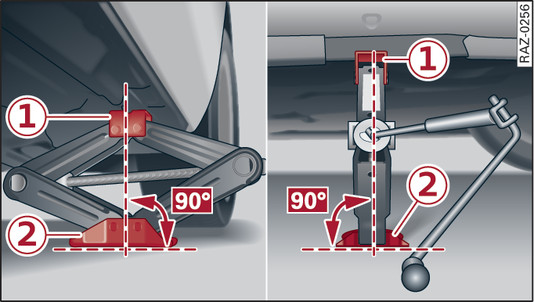|
Always provide a firm base for the jack* on the ground. (The jack can be found in the vehicle s tool kit). If necessary use a large, strong board or similar support. On a hard, slippery surface (such as tiles) use a rubber mat or similar to prevent the jack from slipping ►.
Locate the marking on the door sill closest to the wheel being changed
Fig. 295►.
The jacking point is located behind the marking under the door sill.
Turn the knob to wind up the jack* underneath the jacking point on the door sill until the claw of the jack -1- completely surrounds the seam on your vehicle.
Align the jack* so that its claw -1- fits around the seam and the base plate of the jack -2- is flat on the ground. The base plate -2- must be positioned vertically underneath the jacking point -1-.
Now fit the crank handle onto the jack* by inserting it in the opening on the knob. Turn the crank handle clockwise or anti-clockwise to secure it in place.
Raise the vehicle by winding the crank handle until the defective wheel is clear of the ground.
- Make sure the jack* is stable. If the ground underneath the jack* is slippery or soft, the jack can slip or sink in - risk of injury!
- Use only the jack* supplied with your vehicle to raise the vehicle. If you use a jack from a different vehicle, your vehicle may slip off the jack - risk of injury!
- Apply the jack* only at the jacking points located behind the markings on the door sill and align it properly. Otherwise there is a risk of injury since the jack* can slip off suddenly if it is not properly engaged.
- On vehicles with air suspension*, the height of the parked vehicle can change as a result of variations in temperature and loading.
- Never start the engine when the vehicle is on the jack – risk of accident!
- If work has to be done under the vehicle, ensure that it is safely supported on suitable stands – risk of injury!


